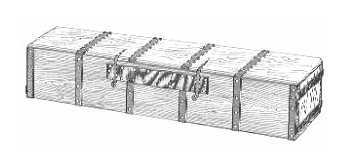
6) Catalogue of extant chests and caskets.
This is a catalogue of the extant chests used for this paper. I have
endeavoured to list them in chronological order. The data collected include
the following: date, origin, collection details, description (type of wood,
dimensions, joinery, lock, no. of hasps and hinges, decoration)) and contents.
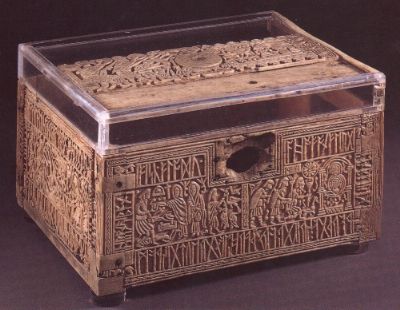
| Date | Origin | Collection details | Description |
| c. 700 | Northumbria, England. | British Museum. | Material: Whalebone. Dimensions: ?
A rectangular prism in shape, the chest is incomplete. The back shows holes for attachment of triangular hinges and the rectangular lock plate is missing. The relief work decoration covers the casket shows a range of themes both pagan and christian. The remains of the lid show Egil the archer defending himself. The front shows Weland the Smith and the Adoration of the Magi. The back shows the sack of Jerusalem by the crusaders. The left side shows Romulus and Remus and the she wolf. The right side shows the death of Sigurd. Runic inscriptions in most cases surround the panels but there is a Latin inscription on the right top corner of the back. A portion of the lid is missing and one end panel has been detached, which is now in the Museo Nazionale del Bargello in Florence, Italy. |
No picture available.
| Date | Origin | Collection details | Description |
| c. 710 – 845 | Whithorn and St Ninian. Chest / coffin fittings (IN32). | 1) 32.101 – 106.
2) 32.201 – 225 3) 32.301 4) 32.401 – 421 5) 32.501 – 513 6) 32.601-2 |
Six (rectangular prism) chest coffins were excavated from this site, very little wood was found but a bounty of fittings were, including; angle irons, hinges, hasps, locks and keys. The angle irons showed a distinctive style with arms narrowing towards rounded terminals. Two of the chests (4&5) had sliding bolt locks and a key) for one (4) was found in the chest. |
Note: Twelve locks (IN33.1-12) or parts of were found in addition to
those on the chest coffins.
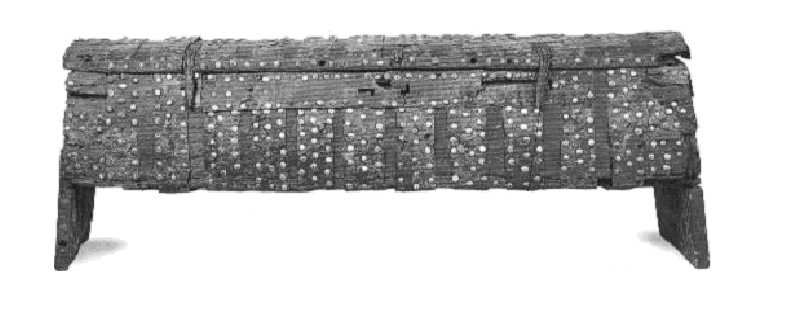
| Date | Origin | Collection details | Description |
| 800 – 850 c. | Oseberg ship burial, Oseberg, Sem, Vestfold, Norway. | Universitetets Oldsaksamling, Oslo, 149. | Wood: Oak. Dimensions: 108cm (top) 113cm (bottom)* 32cm (base) 29cm (top)*38cm. A trapezoid six plank chest, the ends forming the legs, decorated with iron bands (6 – 6.5cm wide), each with three rows of tinned nails. Long slide bolt lock (one end is hooked and there is a central hook for the middle hasp), closed by three hasps with animal head terminals. The curved lid is carved out internally and is attached to the chest by nine simple clamp hinges. This chest contained tools. Contents: two lamps, a comb and a pair of scissors. |
Oseberg (Norway) Chest No. 156.
No picture available.
| Date | Origin | Collection details | Description |
| 800 – 850 c. | Oseberg ship burial, Oseberg, Sem, Vestfold, Norway. | Universitetets Oldsaksamling, Oslo, 156. | Wood: Oak. Dimension: 104cm* 36.5 (base) 28cm (top)* 41cm. Only the bottom, two of the side pieces and the back has been preserved. For all intensive purposes the chest is the same as no. 149. The lid was attached by four hinges. Contents: some hide, cloth, and two combs. |
Oseberg (Norway) Chest No. 178.
No picture available.
| Date | Origin | Collection details | Description |
| 800 – 850 c. | Oseberg ship burial, Oseberg, Sem, Vestfold, Norway. | Universitetets Oldsaksamling, Oslo, 178. | Wood: Oak. Dimensions: 62cm (top) 66.5cm (base)* 24cm (base) 21 (top)* 31cm. Trapezoid six plank chest, the ends forming the legs. Simple lock into an elongated hexagonal plate, closed by a looped hasp. The flat lid is attached to the chest by two hook and eye hinges. Contents: wild apples. |
Note: There were also fragments of at least three other chests in the
find.
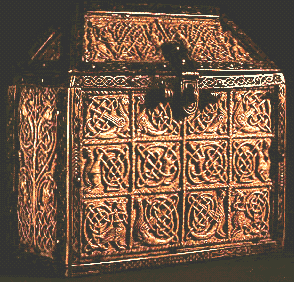
| Date | Origin | Collection details | Description |
| Mid to late 8th century | Gandersheim Monastery. Herzon-Anton-Ulrich Museum, Germany | (?) | Material: Walrus ivory plaques and bronze mounts. Dimensions: L. 12.7cm,
W. 6.67cm, H. 12.7cm. Rectangular box with wedge shaped lid, and hasp closure.
Relief work decoration.
Thought to have been manufactured in southern England. (Bechwith 1972, No. 1 & 2) |
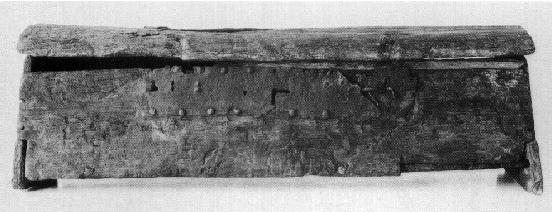
| Date | Origin | Collection details | Description |
| c. 1000 | Mästermyr, Sproge parish, Gotland, Sweden. | Statens Historiska Museum, Stockholm, 21592. | Wood: Oak. Dimensions 88cm (top) 92cm (base)* 24cm (top) 25.6 (base)*24.6cm. A trapezoid six planked chest, the ends forming the legs. The lock consisted of a slide bolt (one end is hooked) locked by two hasps. The curved lid is carved out internally and attached to the chest by two hook and eye hinges. The chest contained a range of tools (metal and wood working), rivets, nails, and metal goods (eg. bells, locks, cauldrons). |
No picture available.
| Date | Origin | Collection details | Description |
| 9th – 10th century | York, pre-Norman cemetery, Burial 76. M438 | Wood: Oak. Length: Unknown. Width: 41 – 46 cm. The lock is a double slide lock with straight ends, used to lock two hasps. One of the hasps is joined to the lid by a hook and eye joint, the other is unknown. Two (possible three) hook and eye hinges closed the lid. The bottom rear edge is strengthened by three corner fittings. | |
| 9th – 10th century | York, pre-Norman cemetery, Burial 105. M1667 | Wood: unknown.. Length: Unknown. A single hasp, attached to the lid by a hook and eye join closes the lock. The lock is a sprung sliding bolt, where the key has to pass a ward to lift a tumbler and thus release the hasp. The lid is attached to the chest by two hook and eye hinges. |
No picture available.
| Date | Origin | Collection details | Description |
| Late 9th – second half of the 10th century | Fyrkat, Jutland, Denmark. | Hobro: grave 4, nos. 8 – 19. | Wood: Oak (poplar later probably used for repairs). Dimensions: 24cm long. A rectangular prism casket consisted of a flat lid, which was held on by two rectangular hinges and had a handle in the centre. The lock consisted of a bifurcated hasp locking a slide bolt lock where the key closed a double leaf spring and a separate lever pulled the slide bolt to release the hasp. |
Note: A similar lock was found Sdr. Onsild, North Jutland, Denmark.
SeeAppendix 1 for more information.
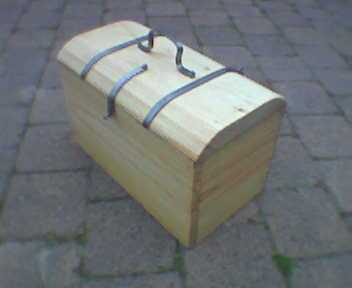
| Date | Origin | Collection details | Description |
Date Origin Collection details Description
10th Century Lejre, Denmark, Grave no. 321. A women’s grave. ? Wood:
Unknown. Dimensions: 37cm*18.5*11cm (depending of my translation of Danish).
Curved lidded casket with handle on top. Lid locked by hasp with animal
headed terminal. Remains indicate a small simple slide bolt lock (item
4i is the tumbler) metal remains indicate metal bracing and decoration
(parallel rows of pewter nails, two enamelled mounts and a circular gold
foil plate with an animal ornament).
Figure . Replica made in pine, without the decoration or metal reinforcing, and hasp closure instead of a slide bolt lock.

| Date | Origin | Collection details | Description |
Date Origin Collection details Description
10th Century Lejre, Denmark, Grave no. 1160. ? Wood: Unknown. Dimensions:
146cm*39cm*31cm. Chest used as a coffin. Rectangular box, no legs. Flat
lid attached by four hook and eye hinges. . The lock is a double slide
bolt (one end is hooked), locked by two hasps. The other metal remains
indicate metal bracing.
Note: Another coffin chest was found at Forlev, Denmark (Brødsted
1936, 191-2, fig. 102).
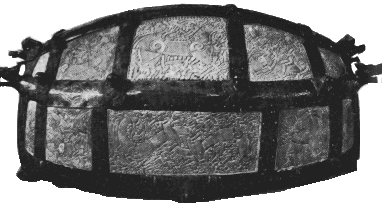
| Date | Origin | Collection details | Description |
Date Origin Collection details Description
C. 1000 with later alterations (base and parts of lock plate. The cathedral
treasury, Kamie? (Pomorski), Poland. Lost at end of WW11. Material:
horn, wood, gilt bronze. Length. 63cm.
(L. 24.8”, W. 13”, H. 10.2”).
Shaped like an inverted boat with truncated ends, The wooden core was covered with twenty two elk antler (?) plates, held together by engraved (vegetal scrolls) gilt bronzed mounts, with cast three dimensional animal and birds heads on the lid. The base and lock plate has been modified.
Similar to the Bamberg casket in ornament.
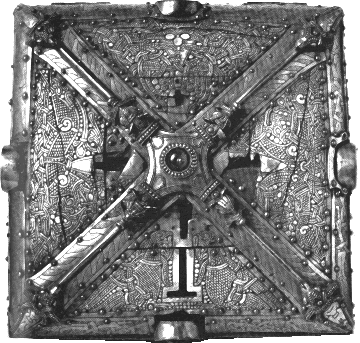 Top.
Top. 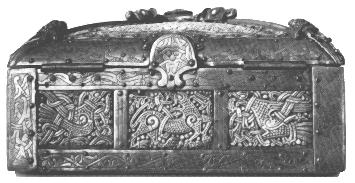 Back.
Back.
| Date | Origin | Collection details | Description |
Date Origin Collection details Description
2nd half of the 10th century. Bamberg, Germany. Bayerisches Nationalmuseum,
Munich, Germany, MA 286. Material: Oak with 16 Walrus ivory (?) plaques.
in a gilt copper frame. Dimensions: L. 26cm, W. 26cm. (10.4 “* 5.1”?)
The walrus ivory panels are carved in Mammen style. The gilt copper from is decorated in a range of styles and patterns. The gilt copper on the lid are also decorated with animal heads.
The casket has a trapezoid lid with an inverted “T” hole in the front part of the lid (it provides access to the original lock mechanism, possibly consisting of a slide bolt?). The centre panel of the front of the casket shows a later keyhole consisting of a vertical slot with a round hole in the middle.
The middle of the lid, which may once have been removable, is decorated
with a spherical rock crystal.
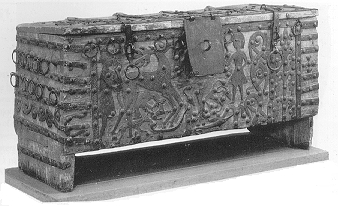
| Date | Origin | Collection details | Description |
| 1200 c. | Voxtorp church, Småland, Sweden. | Statens Historiska Museum, Stockholm, 4094. | Wood: Pine. Length: 146cm. An iron bound and decorated (a hunting scene)
six planked rectangular chest, ends forming the legs. The flat lid is attached
by four hinges and locked by two small hasps at either end of the chest,
plus a large squarish hasp plate that appears to be lockable by a large
loop padlock or chain.
Note: Similar chests are from Rydaholm and Ryssby. |
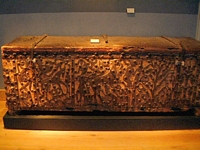
| Date | Origin | Collection details | Description |
| About 1200 A.D. | Rydaholm Church, Småland, Sweden. | Statens Historiska Museum, Stockholm, Sweden. | Wood: ? Dimensions: ?
Six planked chest with very short legs. Three hinges attach the lid to the chest and two hasps, in line with the outside hinges closed the lid. Extensive iron work supports and figures decorate the exterior of the chest (horses, people, trees ,etc.) Very similar to the Ryssby and Voxtorp chests. |
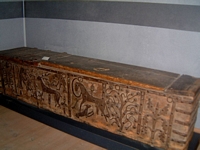
| Date | Origin | Collection details | Description |
| About 1200 A.D. | Ryssby Church, Småland, Sweden. | Statens Historiska Museum, Stockholm, Sweden | Wood: ? Dimensions: ?
Six planked chest with very short legs. Three hinges attach the lid to the chest and two hasps, in line with the outside hinges closed the lid. Extensive iron work supports and figures decorate the exterior of the chest (horses, people, trees ,etc.) Very similar to the Rydaholm and Voxtorp chests. |
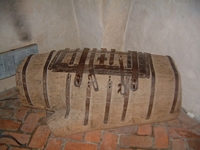
| Date | Origin | Collection details | Description |
| 12 century | Gamla Uppsala, Sweden | ? | Wood: ? Length: ?.
An iron bound dug out chest, closed by seven hasps. |
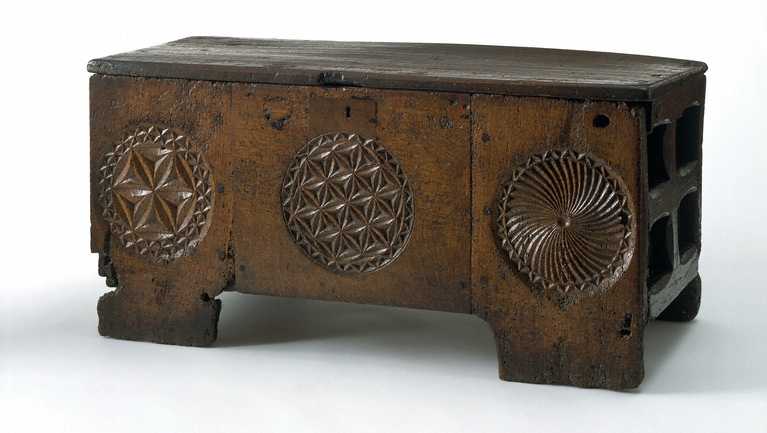
| Date | Origin | Collection details | Description |
| 12th – 13th century | England. | Victoria and Albert Museum, Museum Number W.30-1926. | Wood: ? Dimensions:?
Hutch chest with medallion chip carving in the middle and leg panels of the front. Cross timbers on end. Turn key lock in small rectangular lock plate. No hasp remains on lid, some damage to lid above lock plate. |
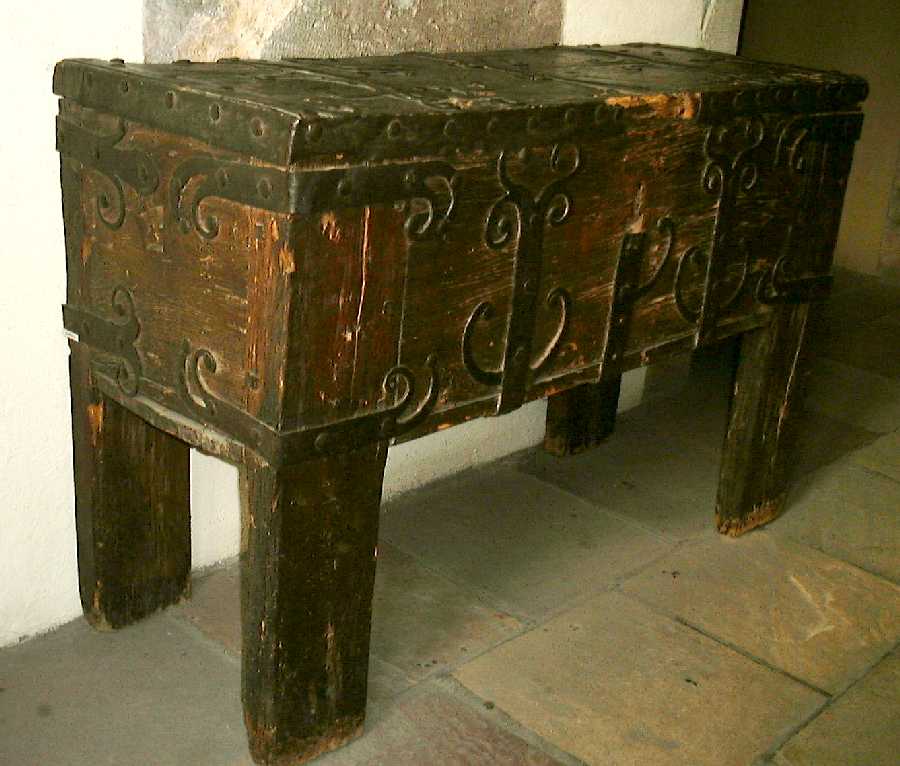
| Date | Origin | Collection details | Description |
| 13th century | ? | l'Oeuvre Notre-Dame Museum in Strasbourg, France. | Wood: ? Dimensions: ? ,
Long legged rectangular hutch chest with iron bracing apparent on the lid, front and side. Hasp plate and hasp appear to have been removed in the past. (Photo source: http://www.greydragon.org/furniture/oeuvre.html) |
Swallowcliffe Down Casket (England).
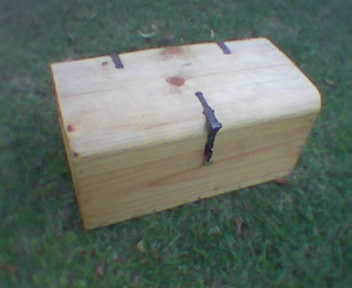
Replica made by author, no ring on lid, and hasp and hasp plate
instead of lock.
| Date | Origin | Collection details | Description |
| ? | Saxon bed burial on Swallowcliffe Down, England | ? | Wood: maple (Acer sp.). Dimensions: 31cm* 18cm*10.5cm (the height is a speculation by the source based on the position of the lock plate plus 3cm). Curved lid with bronze ring handle, attached to the casket by two triangular bronze hinges. The casket is locked by a bronze hasp (which terminates with an iron ring) being secured by a simple slide bolt. The remains of the simple key are also extant. The casket is reinforced by four corner brackets (one was brass, the other were bronze). Contents: bronze spherical container with ring ended handle, spoon, five safety pins, one amber and one glass bead, and a pair of knives. |
No picture available.
| Date | Origin | Collection details | Description |
| ? | Finglesham Cemetery, Kent, grave 95. | ? | Material: Maple, (Acer sp.) Dimensions: 19cm*13cm*9cm. Curved lid,
bronze triangular hinges and hasp. Ring handle on lid made of iron.
Very similar to the Swallowcliffe Down Casket. Note: There were fourteen such caskets found at the Finglesham cemetery, were the wood could be identified; the wood from ten were made from beech (Fagus sp.), the two (from grave 62b) were made from a fruit wood (Pomoideae family) such as Pear (Pirus sp.), apple (Malus sp.) or Hawthorn (Crataegus sp.), and of course maple (Acer sp.) as mentioned above. |
No picture available.
| Date | Origin | Collection details | Description |
| ? | St. Severin, Grave 73, Cologne, France. | ? | Smaller than the Swallowcliffe Down casket, it as a trapezoidal lid,
and a hasp and lock plate not unlike Swallowcliffe.
(Fremersdorf 1941, fig. 2).
|

| Date | Origin | Collection details | Description |
| Viking period | Birka, Sweden, Grave no. 639. | ? | Only the metal fittings are extant. Possibly a casket because of the presents of a handle for the top. Wood: Unknown. Dimensions: Unknown. Six planked rectangular prism (no legs). The flat lid was attached by five simple clamps. On top of the lid was a decorated handle (both ends ended in small animal heads), attached to the lid by a split pin at either end. The lock is a double slide bolt (one end is hooked), locked by two hasps with animal terminals. The lock plate and part of the key are also extant. Other metal remain indicate iron reinforcing on lid, front, back and sides. |
Birka Caskets (Sweden).
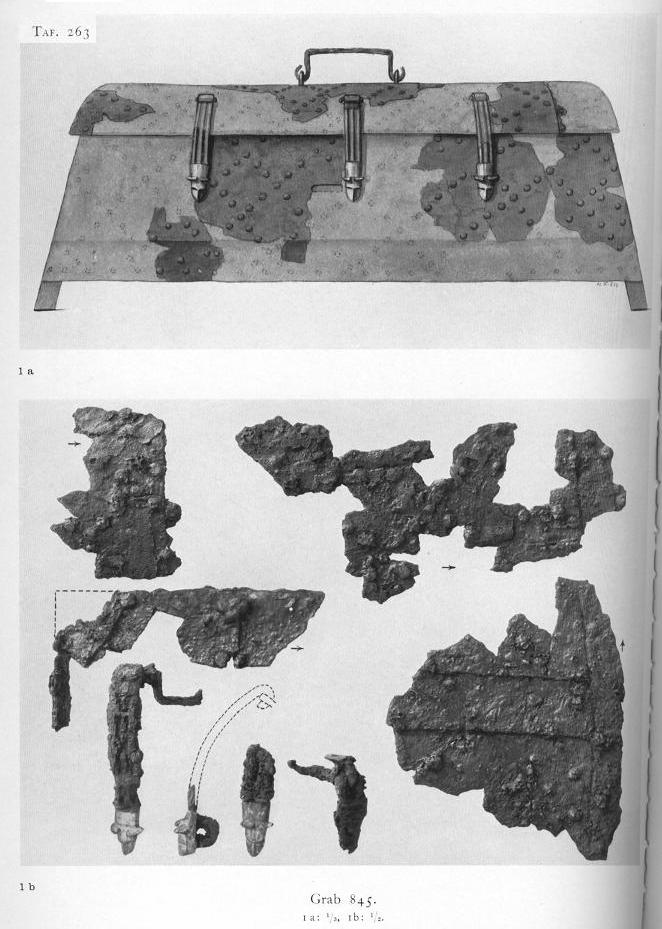
| Date | Origin | Collection details | Description |
| Viking period | Birka, Sweden, Grave no. 845 | ? | Only metal fitting extant. Possibly a casket because of the presents
of a handle for the top.
Wood: Unknown. Length: Unknown.
Curved (?) lid closed be two hasps which end in animal terminals. The lock is a double slide bolt (one end is hooked), locked by two hasps with animal terminals. The lock plate and key are also extant. Other metal remain indicate some iron reinforcing. |
Notes: There is a range of extant metal fittings from chests and caskets
from the same site. See grave find numbers; 24 (two handles (end of chest
(?), slide bolt key), 67 (handle, metal bracing), 353 (nails, split rivet,
hinges, and handle), 367 (casket handle with split pins), 559 (handle and
turn key), 585 (triangular lock plate and turn key), 644 (round headed
nails and metal bracing), 708 (hinge, and two keys), 739 (lock plate, keys,
and handle), 791 (animal headed hasp terminals and handle), 965 (turn key,
triangular lock plate and round headed nails), 978 (hasp), 1083 (handle
for casket, turn key and other metal fittings), Ohne Grab-Nr (Nr = not
recorded (?), (Hinges, handle, lock plates, and hasp).
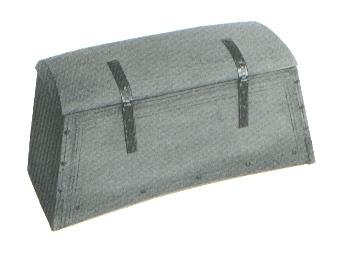 (Replica) See Appendix
2. for plans.
(Replica) See Appendix
2. for plans.
| Date | Origin | Collection details | Description |
| Viking period | The harbour of Hedeby, Denmark. | ? | Wood: Oak. Dimensions: 52cm*23cm*27cm. Trapezoidal six planked chest with curved lid (which was dug out). The lid was held on by two hinges and locked by two hasps (one smaller than the other). The lock plate is missing but I would suggest from the remains and the hole in the front that the lock consisted of a simple double ended slide bolt. The chest is an unique Viking chest because of the simple line carving on the front, back and ends, as well as the curved bottom of the front and back pieces. Contents: a stone. |
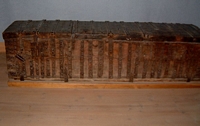
| Date | Origin | Collection details | Description |
| ? | ? | Statens Historiska Museum, Stockholm | Un-dated rectangular prism chest from Sweden's Museum of National Antiquities (Historiska Museet). (Photo Source: http://www.greydragon.org/trips/stockholm/index3.html.) |
Date Origin Collection details Description
,
 Visitors to this page
Visitors to this page
| Copyright © Stephen Francis Wyley 2005
[email protected] |